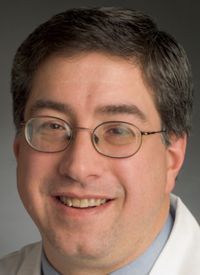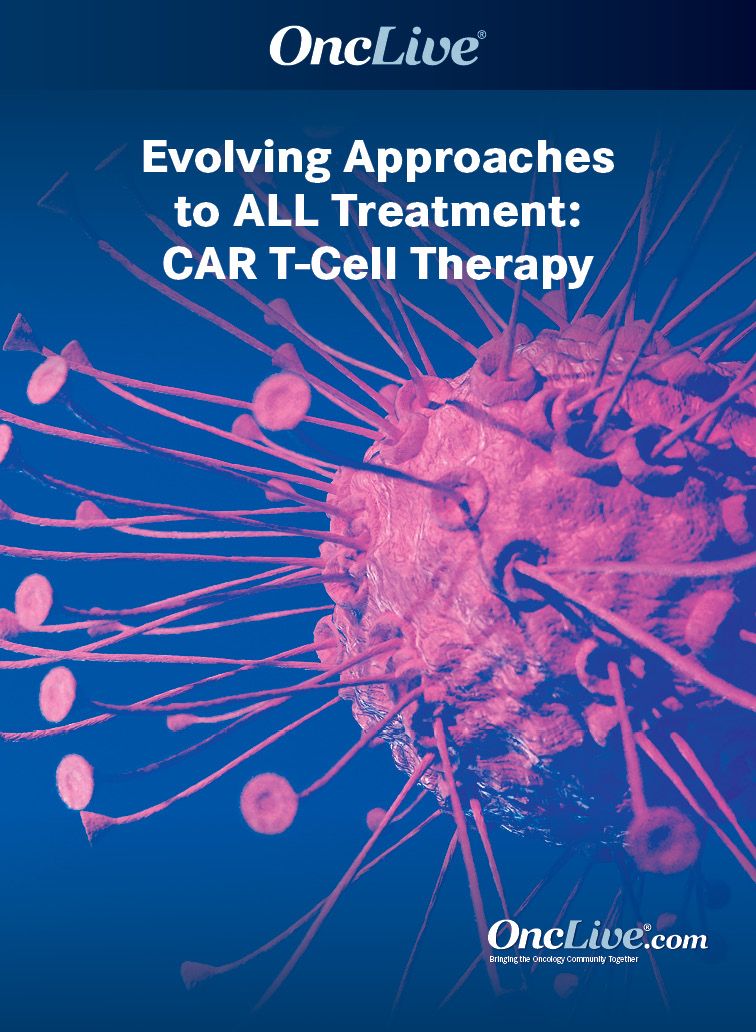Publication
Article
Supplements and Featured Publications
Obe-cel CAR T-cell Therapy Demonstrates Promising Safety Profile in Relapsed/Refractory B- ALL
Author(s):
Daniel DeAngelo MD, PhD, discusses the data seen with obecabtagene autoleucel as a novel treatment in the CAR T-cell arena, emphasizes unmet needs in B-cell acute lymphoblastic leukemia, and highlights important next steps in the study of obe-cel.
Daniel DeAngelo MD, PhD

Obecabtagene autoleucel (obe-cel) appears to be a tolerable and effective treatment in relapsed/refractory B-cell acute lymphoblastic leukemia (B-ALL), eliciting minimal rates of high-grade cytokine release syndrome (CRS), according to Daniel DeAngelo MD, PhD.
The phase 1/2 FELIX trial (NCT04404660) is investigating the safety and efficacy of obe-cel, a CD19-targeted CAR T-cell therapy, in adult patients with relapsed/refractory B-ALL.1 This trial is based on findings from the phase 1 ALLCAR19 trial (NCT02935257), in which obe-cel demonstrated a favorable safety profile in 20 adult patients with relapsed/refractory B-ALL.2
Obe-cel has reduced affinity for CD19, resulting in a faster off rate that reduces toxicity and may reduce T-cell exhaustion, contributing to enhanced CAR T-cell persistence.3 In the ALLCAR19 trial, 15% of patients developed grade 1 CRS, and 40% of patients developed grade 2 CRS. There were no reported instances of grade 3 or greater CRS. These CRS rates are favorable when compared with other agents, noted DeAngelo.
Additionally, 15% of patients experienced grade 3 neurotoxicity, which resolved to grade 1 or lower within 72 hours of steroid administration.
“[The FELIX trial is employing] a double strategy, using a low affinity receptor and double CAR T-cell infusion for safer treatment,” DeAngelo said.
The primary end point of the FELIX trial is overall response rate, with key secondary end points of duration of response, progression-free survival, overall survival, and safety. The FELIX trial has extended its enrollment period to August 2022.
In an interview with OncLive®, DeAngelo, a professor of medicine at Harvard Medical School, as well as a physician and chief of the Division of Leukemia at Dana-Farber Cancer Institute, discussed the data seen with obe-cel as a novel treatment in the CAR T-cell arena. He also emphasized unmet needs in B-ALL and highlighted important next steps in the study of obe-cel.
OncLive®: How has the evolution of CAR T-cell therapy and the development of new agents influenced the treatment landscape of ALL?
DeAngelo: The main issue with relapsed ALL is that it’s difficult to get patients into a second remission. Historically, only about a third of patients have responded to chemotherapy. We have 2 new biologic agents, blinatumomab [Blincyto] and inotuzumab ozogamicin [Besponsa], each with high response rates. However, these should be viewed as bridges to transplant, and the long-term survival with these agents, though an impressive breakthrough, is somewhat limited.
CAR T-cell therapy is augmenting these response rates and hopefully providing a more durable remission, particularly in patients who’ve had prior transplant. Both blinatumomab and inotuzumab ozogamicin have limited efficacy in the post-transplant setting, [where a second transplant is necessary], and CAR T cells are hopefully going to fill that void.
What makes obe-cel unique compared with other CAR T products in ALL?
For a CAR to work, it needs to have affinity with the antibody binding part. Right now, most CARs bind heavily. CAR T cells have high on rates; they stick like Velcro. CARs also need costimulatory domains to activate the T cell.
The novel feature of obe-cel is that it uses a lower-affinity CD19 binder. It has a faster off rate [so it can potentially] mitigate the hyperstimulation of the patient’s own CAR T cells, which would hopefully reduce CRS and neurotoxicity, which are known AEs [adverse effects] of CAR T-cell therapies. Importantly, [obe-cel may also] possibly limit T-cell exhaustion so the CAR T cells are more durable and prevalent after infusion.
How do CRS rates with obe-cel compare with other CAR T-cell therapies?
Obe-cel has been tested in the ALLCAR19 trial, which showed it was associated with a much lower incidence of severe CRS. Grade 1 and 2 CRS were seen, but there were few cases of grade 3, and no cases of grade 4 or 5 CRS. The same was seen with neurotoxicity. ALLCAR19 was a smaller study, but the idea was that a faster off rate from a lower-affinity CD19 binder resulted in less severe T-cell activation, owing to lower rates of CRS and neurotoxicity.
Investigators will further explore obe-cel in patients with relapsed/refractory B-cell ALL in the FELIX trial. What is the rationale for conducting this study, and what are some of the key objectives?
The FELIX trial is taking obe-cel and expanding [its use] into a multi-institutional, international study. This study has several components. First, there’s a phase 1 dose confirmatory lead-in cohort both in patients with active disease and patients with positive minimal residual disease [MRD]. Then, there’s a phase 2 component with 2 parts. Cohort A is the standard relapsed/refractory, histologically active cohort, which includes the bulk of the patients. Cohort B is a smaller exploratory cohort for patients who are MRD positive.
Hopefully, with the primary end point of complete remission or complete remission with incomplete count recovery, we’ll be able to judge the efficacy of obe-cel in both active, relapsed/refractory disease and then compare this safety to other products.
What other CAR T-cell therapies are investigators exploring for patients with ALL?
There are already 2 CAR T-cell therapies approved in the United States. There’s tisagenlecleucel [Kymriah], which is approved for patients ages 22 and under, driven off the [phase 2] ELIANA trial [NCT02435849]. Recently approved from the [phase 1/2] ZUMA-3 trial [NCT02614066] is brexucabtagene autoleucel [Tecartus] for adult patients with relapsed/refractory, CD19-positive disease.
The utilization of these agents has been a bit slow because patients still have to go to the cellular therapy center, have the product made, and get apheresis. There has to be time for that product to be made and confirmed. A lot of bridging therapy is mandated before the cells get reinfused. The other issue with CAR T-cell therapy is the question of whether these are standalone therapies.
How are these issues being addressed? Currently, allogeneic CARs are off-the-shelf therapies, so there isn’t a need to wait for them. Allogeneic CARs are being tested directly against CD19 or CD22. One mechanism of relapse is loss of CD19 antigenicity. CD22 CARs are being explored either by themselves or in combination with CD19 as double-hit CARs. Both CD19 and CD22 CARs are infused to try and abrogate this loss of CD19 as an escape mechanism.
[Those therapies are for] B-ALL. However, 15% of adults will have T-cell ALL, for which there’s no FDA-approved agent. Several studies [are ongoing for this population]. Research that was presented at the 2021 and 2020 American Society of Hematology Annual Meetings investigating a CD7 CAR showed early preliminary data with successful targeting of T-cell disease using CAR therapy.
Many CAR T-cell studies and approvals are in patients with later lines of relapsed/refractory ALL. What are the next steps for testing these agents further up in the treatment setting in these patients?
With CAR therapy, the lower the bulk of disease, the better the response, and seemingly the more durable the response. When patients go in with very active disease and a high burden of disease, the responses are lower, and the relapses are higher. One of the hopes is [to create earlier lines of treatment], moving up therapies that work in the second and third lines.
Right now, for MRD-positive patients, for those who failed to get into a deep remission, the approach is to try to obtain MRD-negative status followed by transplant. We may consider CAR therapy in these patients who were MRD positive after definitive chemotherapy. Or, for patients who experienced MRD-positive relapse, not histologic remission relapse, post-transplant, [we want to know whether] CAR therapy can abrogate their inevitable relapse and demise. Moving these agents up earlier can lower disease burden, and earlier lines of therapy may change the natural history of this disease.
What main message would you like colleagues to know about enrollment and objectives for the FELIX trial?
The FELIX trial is an interesting trial testing 2 strategies. It’s using a lower-affinity CD19 binder to try to make a safer, less toxic CAR T-cell that has a faster off rate, mitigating the high CRS and neurotoxicity rates that we see with currently approved agents. This trial is also testing a double CAR T-cell infusion based on disease burden at registration. It’s not just 1 infusion, and the dose of the initial infusion is dependent upon the bulk of disease. Patients who have a heavy disease burden will receive a lower CAR T-cell infusion as a debulking amount that’s followed by a higher infusion 10 days later. This idea of a double infusion may also mitigate some of the toxicity and expand some of the efficacy, especially the durability, of CAR T-cell therapy.
References
- A study of CD19 targeted CAR T cell therapy in adult patients with relapsed or refractory B cell acute lymphoblastic leukaemia (ALL). ClinicalTrials.gov. Updated May 26, 2022. Accessed June 23, 2022. https://clinicaltrials.gov/ct2/show/NCT04404660
- Immunotherapy for high risk/relapsed CD19+ acute lymphoblastic leukaemia, B-cell non-Hodgkin’s lymphoma (B-NHL) and chronic lymphocytic leukaemia (CLL)/small lymphocytic lymphoma (SLL) using CAR T-cells to target CD19 (ALLCAR19). ClinicalTrials.gov. Updated November 23, 2020. Accessed June 23, 2022. https://clinicaltrials.gov/ct2/show/NCT02935257
- Roddie C, Dias J, O’Reilly MA, et al. Durable responses and low toxicity after fast off-rate CD19 chimeric antigen receptor-T therapy in adults with relapsed or refractory B-cell acute lymphoblastic leukemia. J Clin Oncol. 2021;39(30):3352-3363. doi:10.1200/JCO.21.00917










